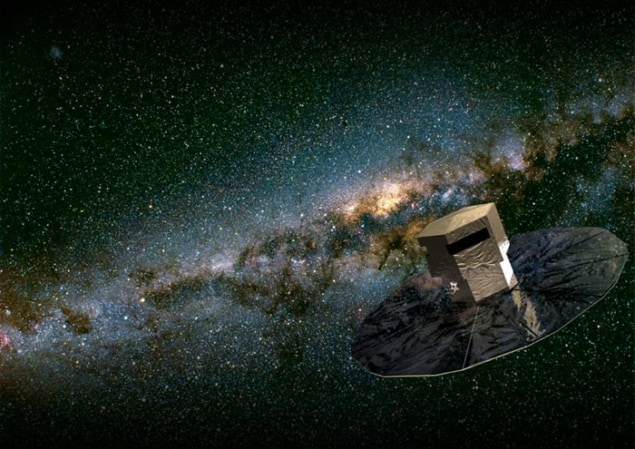
A new type of dark matter that could strongly interact with regular matter to form large discs that would overlap galaxies like our own has been postulated by a group of researchers in the US. There is believed to be at least four times as much dark matter in the universe as there is ordinary matter. But despite its great abundance, dark matter is generally thought to very weakly interact with conventional matter, causing it to form amorphous halos around galaxies that contrast with the richly structured galactic discs themselves. The new research suggests this view may be oversimplified, arguing that a substantial minority of dark matter might in fact interact strongly, and could be detected in cosmic-ray observations.
Dark complex
Much evidence has been accumulated to support the existence of dark matter, which, unlike normal matter, does not give off or absorb electromagnetic radiation. For example, the greater-than-expected rotational speeds of stars in the outer-lying regions of galaxies suggest that those galaxies contain more mass than can be accounted for simply by adding up all of the light.
However, scientists still do not know what dark matter actually is. They do know that much of dark matter interacts weakly with other matter and with itself. Among theorists’ leading candidates for dark matter are so-called weakly interacting massive particles (WIMPs) and axions, which rarely collide with one another. The existence of these particles is also suggested from work in other areas of physics – WIMPs being predicted by some forms of supersymmetry, while axions might explain why strong interactions obey charge–parity symmetry.
More than meets the eye
In the latest work, Lisa Randall and colleagues at Harvard University argue that such weakly interacting particles might not tell us the whole story. By considering the characteristics of the dark matter surrounding our own Milky Way galaxy, the researchers calculate that as much as 5% of that dark matter might not be weakly interacting. They also point out that this “double-disc dark matter” (DDDM), as they call it, would probably dissipate energy while retaining angular momentum from its motion about the galactic centre, causing it to form a thin disc just as ordinary galactic matter does. They work out that the dark and visible discs would have about the same mass, which would imply that the densities of DDDM and normal matter in the universe would be roughly equal.
“Our model isn’t proposed to solve any particular problems,” says group member Matthew Reece. “But we think it’s important to consider a wider range of possibilities for what dark matter might be. We are lucky to be living in a data-rich era, and we want to be sure that we’re not overlooking a dramatic discovery in all that data.”
According to the researchers, DDDM discs would contain the dark-matter equivalent of protons and electrons interacting via an analogue of electromagnetism, so creating dark atoms. The minimalistic model that they have considered in the current work, however, does not include analogues of the nuclear forces, so they have not predicted the DDDM spawning stars, as such. Reece says that he and his colleagues limited themselves to this simple model because it was relatively easy to analyse and work out how it could be tested, but explains that a more complex model, incorporating nuclear physics, could in principle be developed. In fact, he adds, “It doesn’t seem completely out of the question that there could be forms of life made of dark matter,” although he underlines that this speculative idea “isn’t very scientific since we don’t know a good way to test it”.
Detecting dark discs
The dark disc, on the other hand, might be detectable in the near future. Reece explains that evidence for its existence could come from the gravitational effect it has on the motion of the billion Milky Way stars that the European Space Agency’s upcoming Gaia mission will study. Alternatively, he and his colleagues write, annihilating DDDM particles would, given enough sensitivity, produce “strikingly different” signals from those of the ordinary dark matter that the space-based PAMELA, Fermi and AMS-02 detectors are looking out for.
Direct detection, however, would be more difficult. Physicists have built a number of experiments underground that look for any interaction between putative particles of ordinary dark matter and the material in the detectors. But as the Harvard team points out, these detectors would struggle to observe the DDDM variant since the dark disc that is home to this exotic material might not be aligned with our visible one. In addition, even if the two discs were aligned, their relative velocity would probably be too low to generate suitably energetic collisions within the detectors, the team says.
Daniel Hooper, an astrophysicist at Fermilab in the US, says that the Harvard group has put together “an interesting hypothesis” that he predicts “will receive a great deal of interest from many of us working on dark matter research”.
Meanwhile, Roberto Battiston, a physicist at the University of Trento in Italy and deputy spokesman of AMS-02, says that the peculiarly disc-shaped distribution of DDDM might be identifiable with his group’s experiment, if such a substance exists. But he cautions that there could be many competing theories to explain any dark-matter-like signal collected by the detector.
The research is published in Physical Review Letters.



